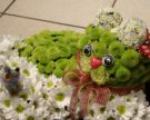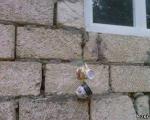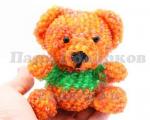Christmas has come and the celebration of the native custom of antiquity begins. Lesson “Christmas has come, the celebration begins! IV
1st grade, 13th lesson. Subject: Christmas has come - the celebration begins
Target: to form the spiritual culture of students through the music of their native people and other peoples of the world.
Tasks:
introduce children to the Orthodox holiday of Christmas
to form a sense of respect for the Orthodox traditions of the Russian people, to encourage students to continue the traditions of the Russian people.
expand the horizons of pupils, develop interest and love for music and creative abilities of students (imagination, memory, attention) through acquaintance with the culture of other countries of the world.
Lesson type: lesson on introducing new material.
Materials for the lesson:
1) presentation
2) audio recordings: “Christ’s Nativity” (P. Sinyavsky); chant “Silent Night over Palestine”; « SilentNight"(English) F. Gruber + "Silent Night" (in Russian); Troparion to the Nativity (church choir)
3) video : “Heaven and Earth” - Russian folk carol; “Shchedrik” is a Ukrainian folk carol.
Equipment : laptop, projector, musical instrument (for teacher), bells (for children)
During the classes:
Organizing time. Musical greeting.
Updating and motivating basic knowledge.
Guys! Today I want to invite you to a holiday! Just guess which one first!
It sounds like “Christ’s Nativity” - lyrics. and music P. Sinyavsky
Guys, have you guessed what holiday we are talking about? (children's answers)
A bright star is burning in the sky,
Mom says to the children at the Christmas tree:
“In the whole world there is a celebration -
Christmas is coming!
Our lesson today is dedicated to the great Christian holiday - the Nativity of Christ. In our country, the holiday of the Nativity of Christ will be celebrated after the New Year, namely on the night of January 6-7. And today we will learn about the history of the holiday.
III. Conversation. PRESENTATION.
CHRISTMAS ORTHODOX
SLIDE 1. It is known that the Mother of God, on the eve of the birth of her Son, came to Bethlehem with her husband Joseph. Bethlehem is a small city, and there weren’t enough places in the hotel for everyone. Therefore, Mary and Joseph stopped for the night in a cave. There were many such places in those parts - shepherds drove their cattle there at night. On the same night Christ was born. The baby was placed in a manger - a feeding trough for livestock.
Let's close our eyes, listen to the chant called “Silent Night over Palestine” and imagine how it was.
Listening - fragment of the chant “Silent Night over Palestine” (choir)
SLIDE 2. The shepherds bowed to Jesus first, then the wise men came - the wise men. These sages lived far to the east. They foresaw the birth of the Savior and when they saw a guiding star in the sky, they went after it. This star is called the Star of Bethlehem. The wise men brought gifts to the God-Infant. In Rus', Christmas was especially looked forward to. First they celebrated it, and then celebrated the New Year. Therefore, it is customary for Christians to decorate Christmas trees just for Christmas. In 1918, Russia switched to a new time. Because of this, New Year comes first and only then Christmas.
All over the world, Orthodox Christians celebrate this holiday. And at Christmas time you can hear a song that people all over the world can sing in the language of their country.
Listen to the sound of this song in English.
Sounds " Silent Night " (English) F. Gruber
What was the nature of the song? (singing, lyrical, tender)
Is the song written in a minor key or a major key? (in major)
Let's listen to how it sounds in Russian.
"Quiet night"
What was the tempo of the song? (slow)
Who do you think performed this song? (choir)
SLIDE 3. Christmas Eve
The day before the holiday is called Christmas Eve. This is a very strict fast day. Christians try not to eat food until the evening. But according to modern tradition, one can fast only until after the festive service a candle is brought into the center of the church and the troparion to the Nativity is sung.
Let us also listen to the troparion to the Nativity.
Where do you think this chant can be heard? (in the church)
What feelings did you have after listening?
We continue to get acquainted with the traditions of the holiday.
SLIDE 4. The evening of this day is called Holy. It is traditionally held with the closest people. They sit down at the table with the first star. It symbolizes Bethlehem, which led the Magi to the born Christ. Housewives prepare twelve Lenten dishes for Holy Evening. The main delicacy is kutia. A little hay is placed under the plate with it as a reminder that Christ was born not in a mansion, but in a poor manger.
SLIDE 5. Kutya
- a dish of boiled grains, usually wheat, with honey and nuts. Later they began to add poppy seeds to it, and even later - raisins. Modern housewives add halva or sugar instead of honey.
SLIDE 6. They drink uzvar during the meal. It is customary to cook Lenten borscht for the holy evening, prepare salads with vegetable oil, dumplings with Lenten filling, pies, and fish dishes.
SLIDE 7. According to tradition, people on the eve of the holiday they decorate the Christmas tree and also walk and sing carols. Everyone can carol – both adults and children. It is customary to give gifts to those who brought good news to the house - sweets, fruits, money - whatever they can.
And now we’ll see how they warmly celebrate the Nativity of Christ in Russia!
Video. Russian folk carol "Heaven and Earth"
What musical instruments do you think can be used to accompany your performance during caroling? (Bells, bells, tambourine, spoons and other instruments.)
Vocal - choral work.
Learning the carol "Good evening to you" (the teacher hands out bells to the children).
1) Good evening to you, gentle owner
Rejoice, oh rejoice, earth,
The Son of God was born.
2) To you, master, with good news,
Rejoice, oh rejoice, earth,
The Son of God was born
3) There in Jerusalem the people said:
Rejoice, oh rejoice, earth,
The Son of God was born.
Generalization of what has been learned. Lesson summary.
So, what do you remember about the holiday of the Nativity of Christ? What events is this holiday associated with?
What Christmas songs did you hear in class today?
Whose image do Christmas carols and carols glorify?
Lesson summary). “Christmas has come - the celebration begins”
Lesson 6 (1-2-6). "Christmas has come - the celebration begins" The purpose of the lesson: touch on high themes of spiritual life.Musical material: - "Quiet night". International Christmas Carol by F. Grubber;- “Shchedrik”, Ukrainian folk carol;- “Riu, riu, riu”, European folk carol;- “The Nativity of Christ”, carol;- “Everyone is coming, hurrying to the holiday,” carol;- “Let's go together to Bethlehem” by E. Kaverin;- “Silent night over Palestine” (folk Slavic chant);- “Lullaby” (Polish folk song);- “The Shepherds Hurry to Bethlehem” (children’s folk song);- “The Winter's Tale” by S. Krylov.Lesson problem: where is the song playing? Additional material: spread of the textbook-notebook “Christmas has come - the celebration begins” and “Native custom of antiquity”.
During the classes
1. Organizing time.
Guys, look where the Muse is inviting us?(On holiday).
Our lesson today is dedicated to the big holiday - the Nativity of Christ.
On December 25, all of Europe will celebrate this holiday. Christmas will come to Russia on January 7th.
What does the word "Christmas" mean?(Birth).
- Who was born on this day?
The name of the newborn was Jesus, then they began to call him Christ, which means “king”, “anointed one”.
2. Working with a presentation (video).
This greatest miracle happened in Bethlehem (Palestine). Then a new star lit up in the sky. She pointed the way to the place where baby Jesus was born.
The wonderful events of that night were sung by poets, artists, and musicians all over the world.
Christmas is a holiday for children and adults with songs, games, and gifts. This is a holiday at the Christmas tree, with the glow of candles and the smell of resinous pine needles.3. Deepening the topic of the lesson. - Today Muse will tell us about how people celebrate this event.Listening to Christmas songs: - “Let's go together to Bethlehem” by E. Kaverin (video fragment);- Angels in the sky sing a song;- Christmas - carol(These songs radiate joy. They have easy-to-remember melodies and simple rhythms.) It is recommended to listen to the song “Silent Night” by F. Gruber (an international Christmas anthem) with children in a recording (in the phonochrestomathy it is performed in English by the choir of King's College Cambridge under the direction of D. Willcock). I also offer a video file of the song “Silent Night” performed by two girls, sisters, I can’t find their last name, I remember their performance with this song at the Yermolov “We Are Together” competition4. Carols. Slavic folk carol songs are associated with ancient rituals. On Christmas (December 25/January 7) and New Year, children and adults went from house to house with congratulations, songs, a star and a nativity scene (a box with wooden toys in the form of a cave, reminiscent of the one in which Christ was born). This ritual was called caroling or glorification.Today we will learn and perform folk carol songs:- "Nativity",- “Everyone is coming, hurrying to the holiday.”- Let's come up with wishes for the “good people” you will visit for Christmas.At the end of the lesson we will repeat the songs that we learned for the New Year holiday. (It is suggested to learn S. Krylov’s song “The Winter’s Tale”, but I think that for my children it is difficult to remember; I teach simpler ones.Item: Music.
Class: 1 class.
Subject:"Christmas has come, the celebration begins."
Lesson type:primary assimilation of new knowledge.
The purpose of the lesson:create conditions for introducing students to the Orthodox Church
musical culture and traditions of celebrating the Nativity of Christ.
Tasks:
Personal education and development: nurturing interest in the traditions of the Orthodox holiday of the Nativity of Christ and the history of its origin;
Metasubject:develop the ability to plan your actions in accordance with the task and the conditions for its implementation, the ability to explain your choice, construct speech statements, answer the question posed, and give arguments; ability to work in a team;
Subject:acquaintance with folk songs and carols;
development of choral performance skills using the example of learning carols.
Planned result: involvement in folk culture
Materials:
· Presentation "Christmas"
· Cartoon "Christmas"
· Video clip of the Christmas carol “This is a Holy Night”
· Video fragment “The Bright Holiday of Christmas”
· Audio file "Barynya", Russian folk dance song
· Musical instruments (bells, tambourines, rattles)
· Christmas tree, Christmas tree decorations for the game.
· Souvenirs "Angels"
Technologies and methods:
Verbal methods (conversation, dialogue)
Visual(illustrations for the theme “The Nativity of Christ”)
Practical(singing in a group, dancing in a group, singing carols with musical instruments)
Reflexive(reflective questions and resource circle)
Lesson progress: (slide 1)
A bright star is burning in the sky,
The angel says to the children at the Christmas tree:
“In the whole world there is a celebration -
Christmas has come!
Teacher: Hello, dear guests! Hello, our long-awaited holiday! Hello, our Christmas tree!
Our lesson today is dedicated to the big holiday - the Nativity of Christ.
What does the word mean "Christmas"?(Birth).(slide 2)
Who was born on this night? The newborn's name was Jesus, then they started calling him Christ, What does "king" mean?
This greatest miracle happened in Bethlehem(Palestine). Then a new star lit up in the sky. She pointed the way to the place where baby Jesus was born. This miracle happened on the night of Jan. 7.
Guys! It seems to me that each of you would like to witness that wonderful Christmas night! Want to?
Children-Yes!
Teacher:-Well, then listen and watch!
(watching the cartoon "The Nativity of Christ") https://www.youtube.com/watch?v=hC34gbMe0Do (05.00)
Teacher: All over the world, Orthodox Christians celebrate this holiday. In all languages the nations praise the Lord.
On the holy night of the Nativity of Christ, all Orthodox churches are as bright as day from the multitude of burning candles and lamps. (Slide 3, illustrations) Christmas carols and prayers do not stop. We are now going to listen to one of the most famous Christmas carols, “This is a Holy Night”
Listening to "This Night Is Holy"
(not all, with pauses)
2 verses sound
Teacher: Did you like the music?
What did this music sound like? Fun and playful? (Solemnly, calmly, evenly)
1 more verse sounds
Who performed this chant? (male choir)
1 more verse sounds
Have you heard musical instruments in this chant? (no, why?
According to Orthodox church laws, singing should not be accompanied by musical instruments. The voices must be heard alone.
Teacher: In Rus', Christmas was especially looked forward to. Christmas is a holiday for children and adults with songs, games, and gifts. This is a holiday at the Christmas tree, with the glow of candles and the smell of resinous pine needles.
On Christmas (January 7), children and adults went from house to house with congratulations, songs, a star and a nativity scene (a box with wooden toys in the form of a cave, reminiscent of the one in which Christ was born). (slide 4) This ritual was called caroling or praise. And the songs that tell about the birth of Christ and honor the owner are called Carols.These are songs of praise. Caroling means singing carols when entering every house.
Everyone can carol - both adults and children.and those who take part in this ritual are called carolers . It is customary to give gifts to those who brought good news to the house - sweets, fruits, money - whatever they can.
Teacher: Today we will try to become real carolers. What musical instruments do you think can be used to accompany your performance during caroling? (Bells, bells, tambourine, spoons and other instruments.)
Performance with musical instruments.


Goal: formation of musical culture of schoolchildren as an important part of spiritual culture.
- educational: introducing students to Orthodox traditions, works of musical and visual art associated with the church holiday of the Nativity of Christ.
- developing: development of students’ creative abilities (imagination, memory, attention).
- educational: formation of respect for the Orthodox traditions of the Russian people and other peoples of the world, through the best examples of folk musical folklore and composition.
Musical material:
- "Silent Night", international Christmas hymn by F.Grubber
- Waltz "Snow Flakes" from the ballet "The Nutcracker" by P.I. Tchaikovsky
- "Shchedryk", Ukrainian folk carol
- "Riu, Riu, Chiu", European folk carol
- Song - carol "The Nativity of Christ"
- Song "Christmas Tree"
- "Barynya", Russian folk dance
- "In the forge", Russian folk song
Equipment: music center, TV, painting, musical instruments.
During the classes
(Children enter the classroom to the music of the Christmas hymn “Silent Night” by F. Grubber)
Musical greeting:
Teacher: (singing) Hello, guys!
Children: Hello, teacher! (singing)
Teacher: Let's start the music lesson now!
Children: Yes, let's start!
(Children sit down)
Teacher: Tell me, guys, what did the music sound like when you entered the classroom?
Children: Light, solemn, joyful!
Teacher: What mood was she in?
Children: The mood of the music was festive and joyful!
Teacher: The music you just heard is called the international Christmas hymn "Silent Night", and it is dedicated to the holiday of Christ.
Her mood was truly festive, bright, like some kind of miracle!
And this miracle happened a long time ago, 2010 years ago!
The son of God, Jesus Christ, was born on earth.
And since then, it has been celebrating the Nativity of Christ for 2010 years!
The teacher points to a picture dedicated to the Christmas holiday (Figure 1).
This painting depicts a biblical story:
What can you say about the characters in the picture?
Children: The heroes are a baby and his Mother, who looks at her son with love and tenderness. Other characters in the picture also rejoice at the birth of Christ.
Teacher: Guys, do you want to know the history of this holiday? Today in class we will get to know her. So listen:
(Sounds like “Waltz of Snow Flakes” from the ballet “The Nutcracker” by P. I. Tchaikovsky)
It was a long time ago: We were in the grip of winter frosts. There were fluffy snowdrifts all around. Sparkling frost enveloped the white snow-covered trees, and a desert cold wafted from the quiet earth. And far, far from our homeland, in the hot country of Palestine, where winter cold never occurs, the baby Christ was born. He appeared near the city of Bethlehem, in a cave where shepherds drove their horses and cows during bad weather.
Late in the evening, on the eve of this event, the parents of Christ - the Virgin Mary and Elder Joseph - reached Bethlehem.
It so happened that no one in the city allowed them to spend the night, and they found refuge in a cave called the Den. Every hour and every minute children are born on Earth.
But when Christ was born, so many unexpected and wondrous miracles happened in the world that people are still amazed by them.
The miraculous events of that night were sung by poets, artists and musicians all over the world. Maybe some of you guys know poems about the holiday of Christmas?
Children read poetry.
Teacher: Christmas is a holiday for children and adults with songs, games, gifts, it is a holiday at the Christmas tree with the glow of candles and the smell of resinous pine needles, because it is no coincidence that the Christmas tree is considered the symbol of the holiday.
The days following Christmas are called "holytide". Children and adults go to visit, congratulate friends, sing songs, dance:
Children perform the "Lady" dance.
Stomp your left foot, stomp your right foot,
Hands on hips, people dance to the lady,
Let's move our left ear, wink with our right eye,
Let's smile to the left, to the right, let's dance the lady to her glory:
This ritual is called caroling or glorification, and those who take part in this ritual are called carolers. For the performance, the owners of the houses treat the carolers with various sweets.
Maybe you guys also went caroling and can tell us about this ritual?
Teacher: Guys, now we will sing a song "Nativity:"
What do people of other countries sing about on this holiday? Interesting? Let's listen!
The Ukrainian folk carol "Shchedryk" and the European carol "Riu, Riu, Chiu" are played.
Teacher: What unites the carols that were sung?
Children: Festive mood:
Teacher: Absolutely right! The Christmas song is heard in all countries where the Nativity of Christ is celebrated!
Teacher: What musical instruments do you think the carolers accompany their performances with?
Children: Ratchets, spoons and other tools.
Teacher: Do you know how to play musical folk instruments?
Teacher: Let's play, come out!
Playing folk and musical instruments, r.n.p. "In the forge"
Teacher: Great! What songs about the Christmas tree are you familiar with?
Children: "Little Christmas tree."
Teacher: Do you know that there is another version of this song? And now you and I will stand together in a round dance and sing it:
Teacher: Now let's remember what new and interesting things you learned in class today. What did you like and remember most?
Teacher: What would you wish for the people you visit for Christmas?
Children: Merry Christmas, good luck with your studies:
Teacher: Well done, I congratulate you on the New Year and Merry Christmas, and in memory of our lesson I give each of you an angel. May it bring you good luck and happiness.
Goodbye children! (singing)
Children: Goodbye! (singing)



